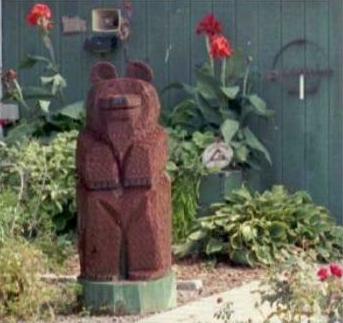 The following was posted in 2001. Review of A Child's Garden: Enchanting Outdoor Spaces for Children and Parents, by Molly Dannenmaier. Simon & Schuster Editions, 1998, 192 pp. Reviewed by Mary Meehan With its striking color photography of children in gardens, this book is a visual delight. It shows wandering brooks, miniature water falls, splendid climbing trees, nifty tree houses. There are prairie-grass meadows, winding paths, hidden play spaces, mazes, ferns and vines and pumpkin patches. And glorious flowers: Russian sage, trumpet vine, purple coneflower, lavender, buddleia, climbing roses, salvia, sunflowers, cosmos, zinnia, coreopsis. The children who wander and cavort around all this beauty--especially the toddlers--are delightful. Author Molly Dannenmaier has a background in garden-magazine editing and has helped design "teaching gardens" for her children's school. Perhaps even more important are her childhood memories of her father's gardens. A "farm-raised son of the South," he grew everything from strawberries and pumpkins to lilies and roses. She says that the perpetual busyness of today's parents, coupled with child-safety worries, means that many parents "are unwittingly cutting off children from seminal life experiences available only during lazy outdoor afternoons." When children are curious about natural life, "we offer them books, television shows, and computer learning programs instead of taking them outside to touch, feel and smell the real thing." Children's gardens are an excellent remedy for this problem, as Dannenmaier shows with descriptions and photos of both public and private gardens. A good children's garden, she suggests, is not an adult garden on a smaller scale. Rather, it takes account of children's need to run and jump and climb trees, to dig holes and find secret places. Touches of whimsy--peepholes, beanpole tepees and scarecrows-are very much in order. Dannenmaier also notes the possibility of combining children's and adults' needs. Screening off an area for messy kids' stuff, such as digging holes and playing in the dirt, is one solution. Another is choosing play equipment that blends well with a natural environment. Children, she believes, should be encouraged to grow vegetables and flowers. And to pick them. "A good antidote to the 'don't pick the flowers' rules of public gardens," she says, "is to plant at home an extravagant garden with sweeping swaths of flowers meant to be picked." While she does not put a price tag on any of the gardens, some of the stunning private ones must have required a great deal of money. Yet some of their individual features could be adapted to nearly anyone's backyard. There are also theme gardens that involve imagination and work, but not necessarily much money. Dannenmaier suggests a "performing plants" garden that might include Chinese lanterns, cup plants, money plants, obedient plants and snapdragons. She describes an alphabet garden where each plant group is marked by a large, craft-store wooden letter--"from A for aster to Z for zinnia." She suggests a Tinkerbell garden and a Peter Rabbit garden, even a Wizard of Oz garden. She describes a perfume garden that includes basil, lavender, mints, spice shrub, and roses. Any garden club looking for a new project could use this book to design something splendid for its local school or park. The project might well provide as much fun for adult club members as for children. And for all who see it, a lovely garden adds to the charm and joy of life.  |